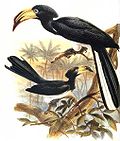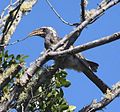| Lophoceros | |
|---|---|

| |
| Crowned hornbill, Lophoceros alboterminatus | |
|
Scientific classification
| |
| Domain: | Eukaryota |
| Kingdom: | Animalia |
| Phylum: | Chordata |
| Class: | Aves |
| Order: | Bucerotiformes |
| Family: | Bucerotidae |
| Genus: |
Lophoceros Hemprich & Ehrenberg, 1833 |
| Type species | |
|
Buceros nusutus (
Linnaeus, 1766)
| |
| Species | |
|
See text. | |
Lophoceros is a genus of birds in the hornbill family, Bucerotidae, which are native to Africa.
Taxonomy
The genus Lophoceros was introduced in 1833 by the German naturalists Wilhelm Hemprich and Christian Gottfried Ehrenberg to accommodate Buceros, Lophoceros, forskålii. [1] This is now considered as a junior synonym of the nominate subspecies of the African grey hornbill (Lophoceros nasutus nasutus). [2] The genus name combines the Ancient Greek lophos meaning "crest" with kerōs meaning "horn". [3]
The species now placed in this genus were formerly included in the genus Tockus. A molecular phylogenetic study published in 2013 found that Tockus was divided by a deep phylogenetic split into two major groups. The genus Lophoceros was therefore resurrected to contain one of these groups. [4] [5]
Species
The genus contains 8 species: [5]
| Image | Scientific name | Common Name | Distribution |
|---|---|---|---|
 |
Lophoceros alboterminatus | Crowned hornbill | northeastern Africa |
 |
Lophoceros bradfieldi | Bradfield's hornbill | northern Botswana, southern Angola and eastern Zimbabwe |
 |
Lophoceros fasciatus | Congo pied hornbill | Nigeria to northern Angola and Uganda |
 |
Lophoceros semifasciatus | West African pied hornbill | Senegal and Gambia to southern Nigeria |
 |
Lophoceros hemprichii | Hemprich's hornbill | Djibouti, Eritrea, Ethiopia, Kenya, Somalia, South Sudan, and Uganda |
 |
Lophoceros pallidirostris | Pale-billed hornbill | Angola, DRC, Kenya, Malawi, Mozambique, Tanzania, and Zambia. |
 |
Lophoceros nasutus | African grey hornbill | Sub-Saharan Africa and into Arabia |
 |
Lophoceros camurus | Red-billed dwarf hornbill | Angola, Benin, Cameroon, Central African Republic, Republic of the Congo, Democratic Republic of the Congo, Ivory Coast, Equatorial Guinea, Gabon, Ghana, Guinea, Liberia, Nigeria, Sierra Leone, South Sudan, and Uganda. |
References
- ^ Hemprich, Wilhelm; Ehrenberg, Christian Gottfried (1828). Symbolae physicae (in Latin). Vol. 1: Avium Part 1. Berolini [Berlin]: Ex Officina Academica. Pages are not numbered. Text and Note 8. Although the year 1828 is printed on the title page, the volume was not published until 1833. See: Dickinson, E.C.; Overstreet, L.K.; Dowsett, R.J.; Bruce, M.D. (2011). Priority! The Dating of Scientific Names in Ornithology: a Directory to the literature and its reviewers. Northampton, UK: Aves Press. pp. 91–92. ISBN 978-0-9568611-1-5.
- ^ Dickinson, E.C.; Remsen, J.V. Jr., eds. (2013). The Howard & Moore Complete Checklist of the Birds of the World. Vol. 1: Non-passerines (4th ed.). Eastbourne, UK: Aves Press. p. 283, Note 8. ISBN 978-0-9568611-0-8.
- ^ Jobling, James A. (2010). The Helm Dictionary of Scientific Bird Names. London: Christopher Helm. p. 230. ISBN 978-1-4081-2501-4.
- ^ Gonzalez, J.-C.T.; Sheldon, B.C.; Collar, N.J.; Tobias, J.A. (2013). "A comprehensive molecular phylogeny for the hornbills (Aves: Bucerotidae)". Molecular Phylogenetics and Evolution. 67 (2): 468–483. doi: 10.1016/j.ympev.2013.02.012. PMID 23438388. See also the correction: Gonzalez, J.-C.T.; Sheldon, B.C.; Collar, N.J.; Tobias, J.A. (2013). "Corrigendum to "A comprehensive molecular phylogeny for the hornbills (Aves: Bucerotidae)" [Mol. Phylogenet. Evol. 67 (2013) 468–483]". Molecular Phylogenetics and Evolution. 68 (3): 715. doi: 10.1016/j.ympev.2013.05.008.
- ^ a b Gill, Frank; Donsker, David; Rasmussen, Pamela, eds. (January 2022). "Mousebirds, Cuckoo Roller, trogons, hoopoes, hornbills". IOC World Bird List Version 12.1. International Ornithologists' Union. Retrieved 10 June 2022.









